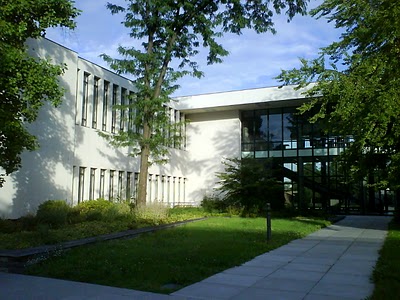Luminous and Transparent: the Henry Ford Bau
 It’s a late summer day and we are riding our bikes around Dahlem, in the South of former West Berlin. We’re not far from where the main army complex of the US forces was located. There is a hint of America in the boulevards, playing fields, suburban houses and relative wealth of the neighbourhood. Squint and you could be in Princeton, NJ. Elderly people take out their vintage cars for a Sunday drive –a Cadillac, a Dodge. We laugh–it’s too uncanny–when we hear oldies blaring from a backyard. Buddy Holly, Elvis Presley? All we need now is a cold glass of root beer.
It’s a late summer day and we are riding our bikes around Dahlem, in the South of former West Berlin. We’re not far from where the main army complex of the US forces was located. There is a hint of America in the boulevards, playing fields, suburban houses and relative wealth of the neighbourhood. Squint and you could be in Princeton, NJ. Elderly people take out their vintage cars for a Sunday drive –a Cadillac, a Dodge. We laugh–it’s too uncanny–when we hear oldies blaring from a backyard. Buddy Holly, Elvis Presley? All we need now is a cold glass of root beer.
We turn a corner and before us is a university building dedicated to Henry Ford. It is renovated, luminous, balanced, one of the best buildings I have seen of its period.

It was built between 1952 and 1953, at the same time that monumental Stalinist buildings were being erected along the Karl-Marx Allee in the East. The establishment of the Free University or Freie Universität Berlin in 1948 responded to the ordeals of students in the East who protested against the imposition of Stalinist ideology in their universities, and were punished by military tribunals with forced labour. The founding of the Freie was of course also a practical move: West Berlin was cut off from the Humboldt University in Mitte and now had no international institution of higher learning. The Americans, looking for opportunities for Cold War propaganda, and desiring to promote and showcase academic freedom, did not spare any expense.

These were some of the first buildings at the Freie, the University Library complex and the core lecture halls. The Ford Foundation (of Model-T fame) donated 8 million Deutschmarks to the project. The main building was dedicated to Mr Henry Ford himself, who had passed away in 1947. It is an ironic dedication, if we think of the Freie as announcing a new era unchained from totalitarian ideology. The automobile fanatic Adolf Hitler actually idolised Mr Ford and decorated him with the Order of the German Eagle (Verdienstorden vom Deutschen Adler) on his 75th birthday in 1938. Ford, for his part, was an anti-Semite and active opponent of the war effort.

One exterior wall looks like it was built with retrieved rubble, perhaps from war damage, a poignant contrast to the polished windows and unblemished expanses of white facade. One can see straight into the lecture halls, the common spaces, from outside. If the building were to express itself in a word, it would be ‘transparency’. The geometry is softened by gently curving surfaces, stairwells, and abundant greenery. The building is unthreatening, comfortable, unlike fascist buildings of a few years earlier. Students are not dominated and defeated.
What must German students here in the fifties have felt? That they had left the past behind? Were they grateful to emerge out of the squalour of capitulation and into a new architecture? Or were they circumspect about yet another ideology? And did they wonder, as their critics in the East did, whether there were too many continuities with fascism? Had German academia really rid itself of the paternalism and hierarchy of the past? What did they think of the name on the wall?
Größere Kartenansicht

